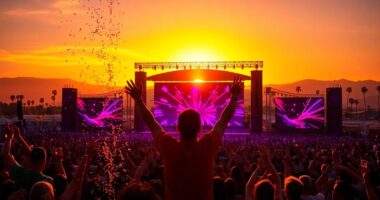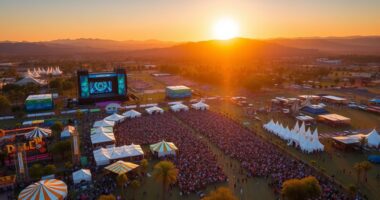Coachella became the ultimate destination for music lovers by evolving from a one-day event in 1999 to a massive festival attracting 125,000 attendees each weekend. You’ll enjoy an eclectic lineup that spans multiple genres and highlights emerging talent. Innovative marketing and social media engagement have also fueled its popularity. Plus, Coachella leads the way in sustainability while shaping trends in the music scene. There’s so much more to discover about its cultural significance.
Key Takeaways
- Coachella evolved from a small two-day festival in 1999 to a major three-day event, attracting 125,000 attendees by 2017.
- The festival features a diverse lineup across genres, showcasing both established and emerging artists, enhancing its cultural significance.
- Innovative marketing strategies, including influencer partnerships and social media engagement, have expanded Coachella’s visibility and connection with fans.
- Sustainability initiatives, such as waste management and water conservation, promote environmental responsibility while benefiting the local economy.
- The festival adapts to trends, incorporating high-tech experiences and a multicultural ambiance, appealing to a wide audience, including Gen Z fans.
The Origins of Coachella: A Historical Perspective
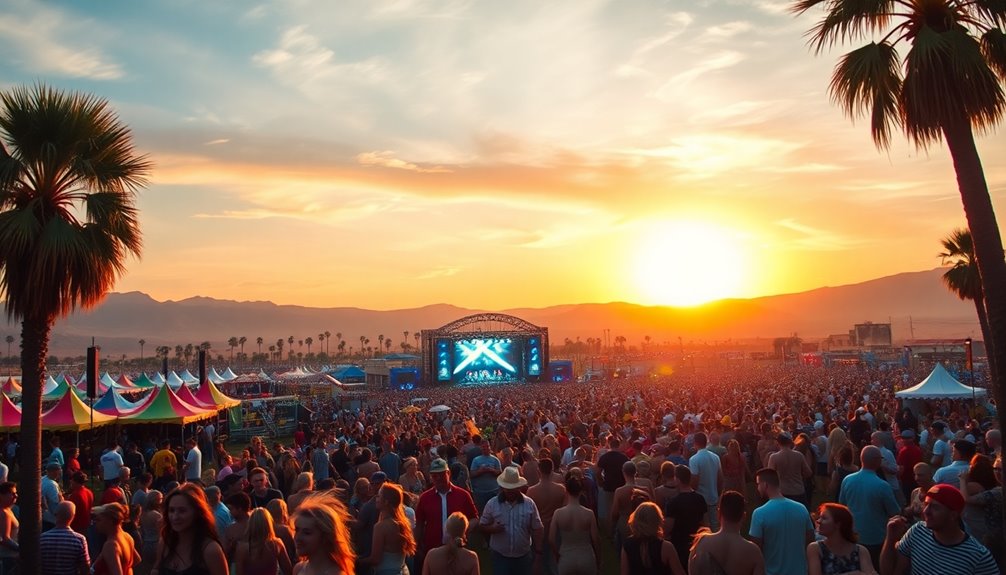
When you think about the origins of Coachella, it’s clear that its inception was inspired by the vibrant European music festival scene. Co-founders Paul Tollett and Rick Van Santen wanted to create a unique celebration of music, art, and culture in the American desert.
The Empire Polo Club was chosen for its remote location, allowing attendees to fully immerse themselves in the experience. The first festival, held on October 9-10, 1999, featured a diverse lineup, including Tool and Morrissey, and drew about 25,000 attendees. The inaugural festival faced financial challenges initially, but the successful Pearl Jam concert in 1993 validated the venue’s potential for large events, paving the way for Coachella’s evolution into a cultural phenomenon.
Growth and Expansion of the Festival
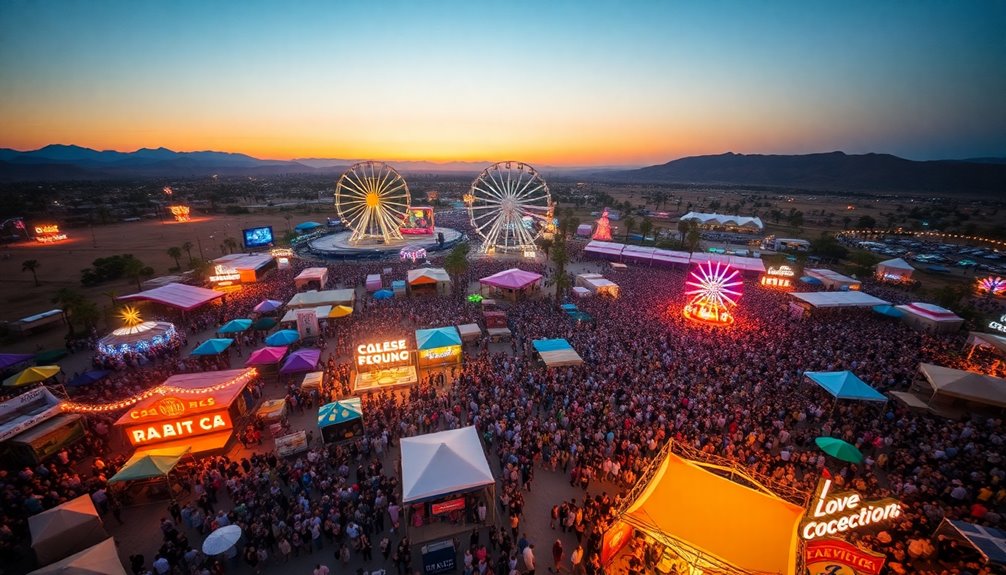
The early success of Coachella set the stage for its remarkable growth and expansion over the years.
Starting as a one-day event in 1999, it quickly evolved into a two-day festival by 2001 and a three-day extravaganza by 2007.
You’d be amazed to see how attendance skyrocketed from 37,000 in its inaugural year to 125,000 per weekend by 2017.
Revenue surged, jumping from $16 million in 2007 to an impressive $114 million a decade later.
Coachella’s economic impact transformed the festival into a cultural phenomenon, drawing attendees and performers from all corners of the world.
This growth not only elevated the festival but also turned the Coachella Valley into a vibrant cultural and economic hub.
A Diverse Musical Lineup
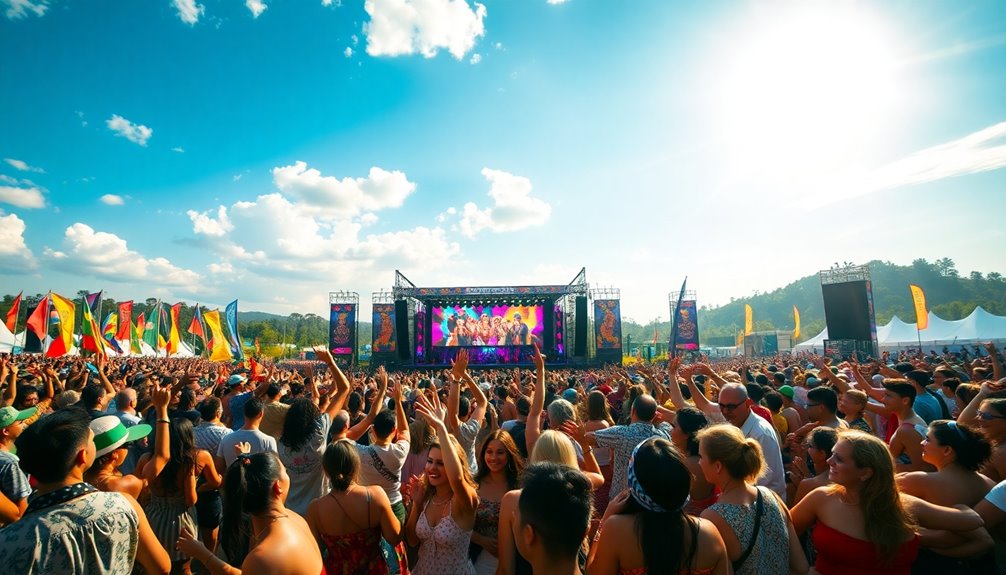
Coachella has transformed into a vibrant celebration of musical diversity, showcasing an eclectic mix of genres that captivates audiences.
From its early years featuring alternative rock acts like Beck, the festival has evolved significantly. By 2002, it embraced hip-hop with Jurassic 5, setting a precedent for future lineups. This evolution mirrors the way social media impacts celebrity reputation, as the festival has adapted to changing musical tastes and trends.
You’ll find artists from around the globe, representing everything from punk rock with Green Day to the electrifying beats of innovative and captivating shows by Post Malone.
Coachella also champions emerging talent, providing a platform for new artists to gain exposure and launch their careers. With K-pop sensations like ATEEZ and indie icons like Lady Gaga, the festival’s commitment to diversity not only entertains but fosters a rich cultural exchange that resonates deeply with fans.
Innovative Marketing Strategies
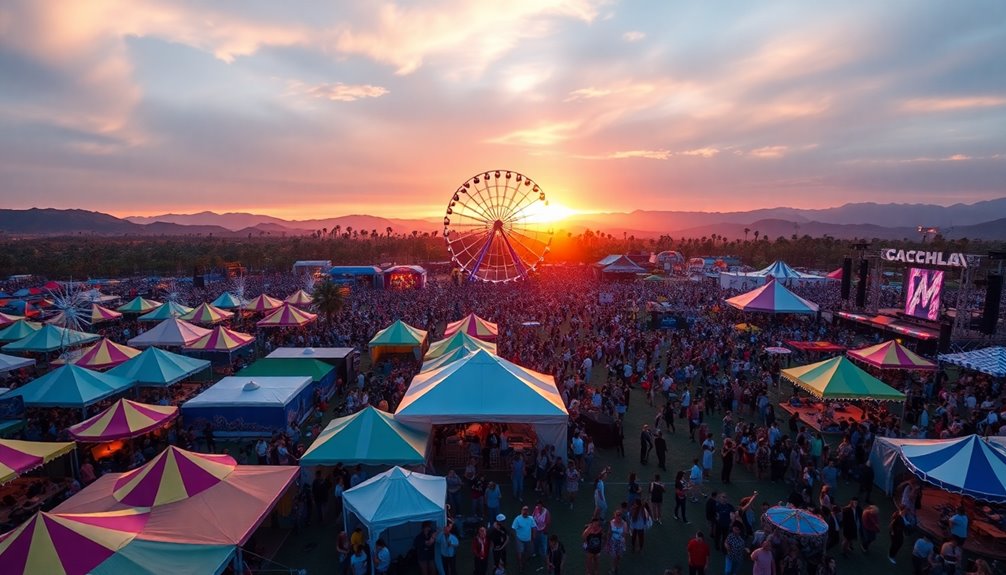
With a rich lineup of diverse artists capturing attention, the festival has also become a hub for innovative marketing strategies that enhance the overall experience.
Influencer partnerships play a crucial role, with brands collaborating with popular figures to reach vast audiences on platforms like Instagram and TikTok. For instance, TikTok star Alix Earle’s tie-up with Poppi soda showcases the organic pull of influencers. Influencers not only elevate brand visibility but also create authentic connections with festival attendees. Additionally, these partnerships can reflect astrological compatibility, as influencers resonate more effectively with their audiences when their personal styles align with brand values.
Furthermore, experiential marketing thrives at Coachella, with brands like 818 Tequila creating engaging pop-ups that festival-goers love to share.
Social media engagement further fuels excitement, as attendees post their experiences, fostering loyalty.
Ultimately, strategic brand partnerships with major names like Absolut heighten the festival’s appeal while connecting brands with millennial and Gen Z audiences.
Cultural Significance and Influence
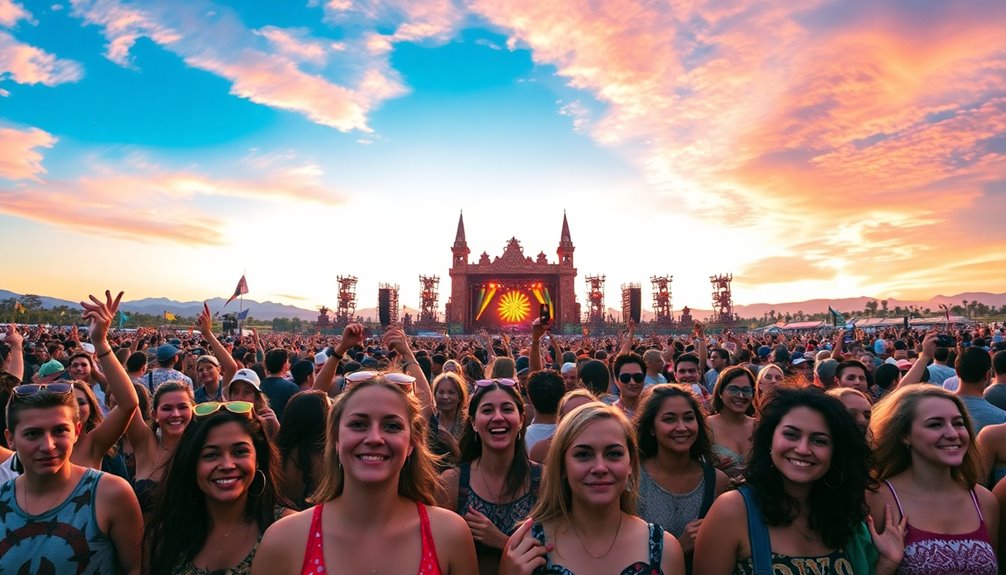
As you immerse yourself in the vibrant atmosphere of the festival, you’ll quickly realize Coachella’s profound cultural significance. This iconic event serves as a launching pad for emerging artists and a reinvention stage for established acts, reflecting a diverse lineup that spans multiple genres. Artists like The Killers, Arctic Monkeys, and Adele have all gained traction here. Coachella’s influence extends beyond music, shaping trends in global pop culture and fostering inclusivity among attendees. The festival now spans two weekends every April, showcasing legendary performances and emerging talent. Social media amplifies this cultural touchstone, creating virtual experiences for millions worldwide. The festival also showcases interactive art installations, enriching the overall experience and attracting diverse audiences. Ultimately, Coachella embodies the evolving face of American culture and its global impact, similar to the way female participation is rising in esports, illustrating a broader trend of inclusivity in various cultural spheres.
The Role of Fashion at Coachella
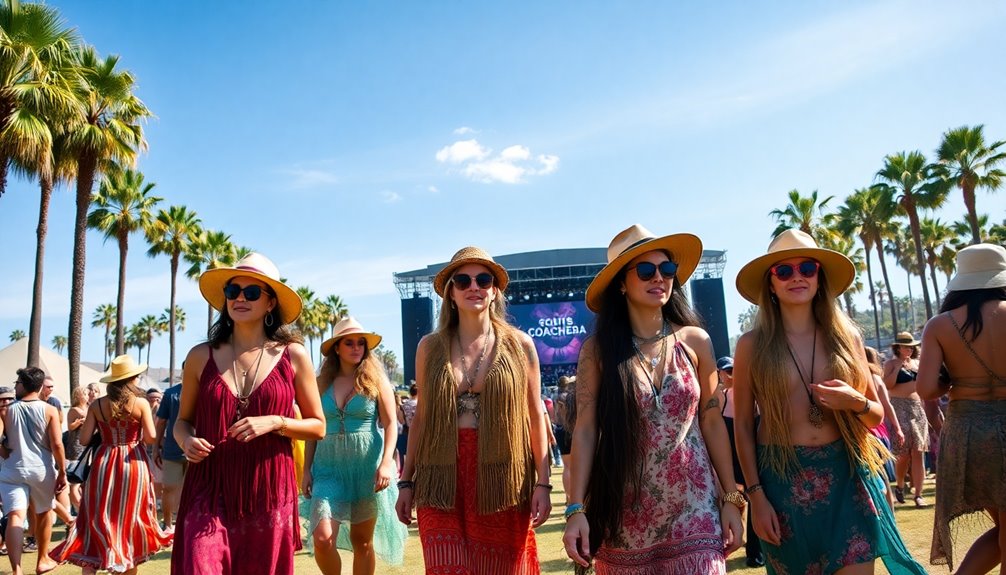
While attending Coachella, you’ll quickly notice that fashion often takes center stage, sometimes overshadowing the music itself. Early on, attendees sported casual looks, but the 2010s ushered in a bohemian vibe with wide-brim hats and vintage denim.
Nowadays, social media fuels this trend, with influencers like Kendall Jenner setting bold fashion statements. The festival has evolved into a platform for artistic expression, where outfits often steal the spotlight. This is evident as Coachella has now embraced diversity in representation by featuring a lineup that highlights a variety of non-white artists.
Recent trends blend bohemian and futuristic styles, embracing gender-fluid fashion and sustainable practices. Coachella not only showcases unique styles but also reflects broader fashion trends, making it an essential experience for anyone keen on the latest in festival fashion.
Challenges Faced Over the Years
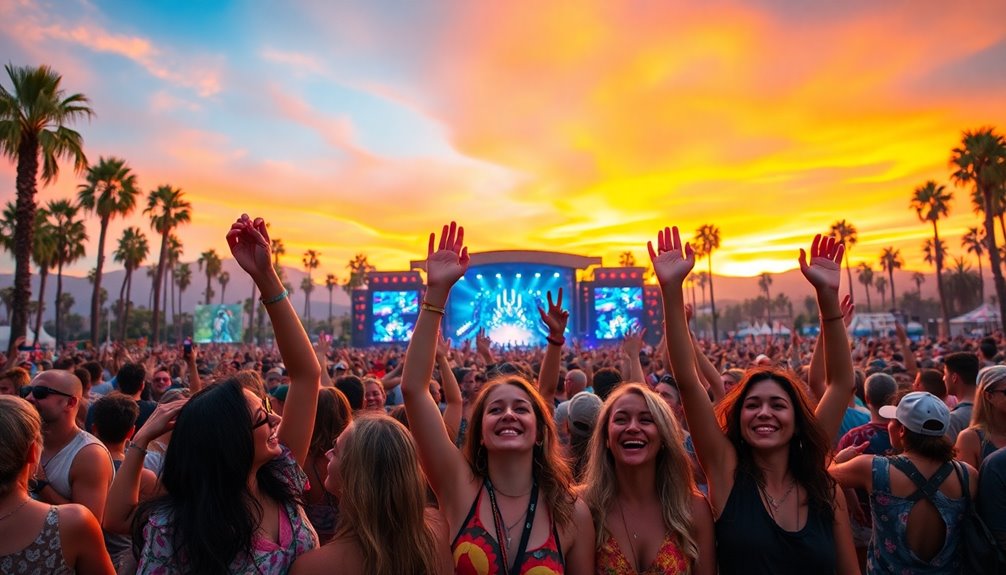
Although Coachella has become an iconic festival, it hasn’t been without its fair share of challenges over the years. You might recall that the inaugural event in 1999 lost $850,000 and faced cancellation in 2000 due to financial instability.
Even today, last-minute lineup changes can lead to significant losses, as seen with Frank Ocean’s withdrawal in 2023. Extreme desert heat has also posed significant logistical issues, prompting scheduling shifts to avoid the scorching temperatures. Additionally, the festival has had to navigate the changing demographics of its audience, as seen in the rise of TikTok personalities influencing festival culture.
As attendance grew, managing crowds became increasingly complex. Moreover, artists’ unique demands, like Kanye West’s giant dome request, have tested organizational limits.
Despite these hurdles, Coachella continues to adapt and thrive, solidifying its place in the music festival landscape.
The Impact of COVID-19 on the Festival
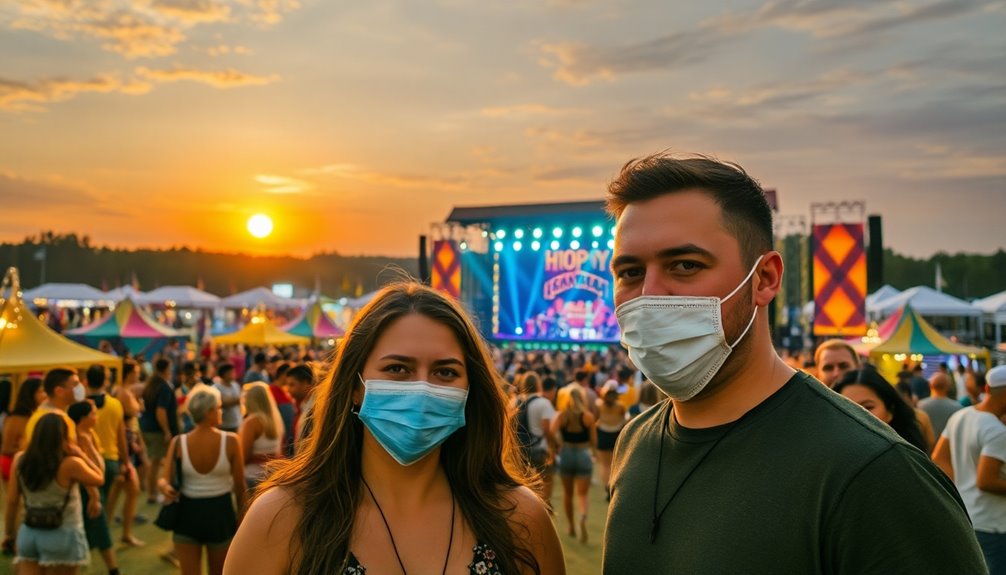
The COVID-19 pandemic significantly impacted Coachella, reshaping how the festival operates and how attendees experience it. Initially, strict safety protocols were in place, requiring vaccinations and masks. However, by 2022, these mandates were lifted, reflecting California’s relaxed guidelines. Even without official requirements, health officials recommended vaccinations and masks due to the festival’s international audience. Goldenvoice rescinded all COVID-19 safety protocols, which raised concerns among some attendees, but Coachella still sold out both weekends that year, showcasing its enduring popularity.
The festival’s return was crucial for local economies, supporting hotels and restaurants. Ultimately, Coachella’s adaptability highlighted its relevance and influence, setting a potential trend for other festivals navigating post-pandemic realities while balancing community health concerns with economic needs.
Sustainability Initiatives at Coachella
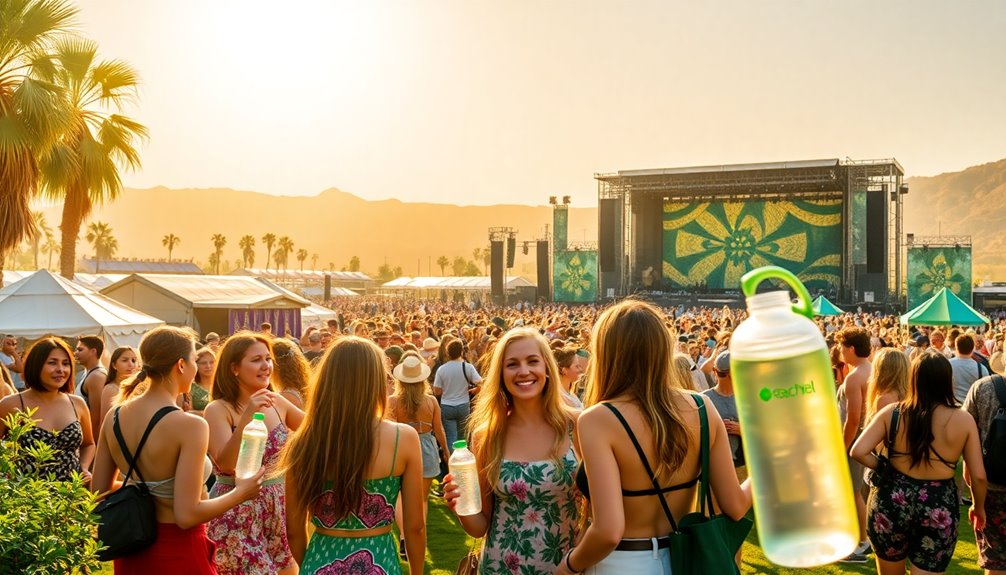
As music lovers flock to Coachella, they also find themselves part of a growing movement towards sustainability. The festival promotes water conservation with refill stations and encourages the use of reusable bottles. Solar panels and LED lighting help reduce energy consumption, while partnerships with local organizations enhance waste management and environmental education. You’ll notice the ban on single-use plastics, along with massive recycling programs and composting facilities to minimize waste. Plus, interactive art installations emphasize the importance of reusability. Attendees can even trade recyclables for merchandise or food vouchers, making sustainability a fun part of the experience. Coachella’s financial impact commitment to eco-friendly practices ensures that it remains a leader in the music festival scene while caring for the environment.
The Future of Coachella: Trends and Adaptations

With music lovers constantly seeking fresh experiences, Coachella is embracing trends and adaptations that reflect the evolving landscape of the festival scene.
The lineup now spans various genres, showcasing both established and emerging artists, with TikTok driving viral success. You’ll notice a new stage dedicated to electronic music in 2024, highlighting its growing prominence. Coachella 2024 showcases a fusion of technology and personal style through high-tech wearables, allowing attendees to engage with live performances like never before. This integration of predictive analytics enhances personalization, tailoring experiences to individual preferences.
Social media plays a crucial role too; influencers flock to Coachella, blending fashion and music while enhancing the festival’s authenticity.
Technological innovations, like high-tech wearables, enhance your experience, and interactive art installations captivate attendees.
As demographics shift, expect a vibrant mix of Gen Z fans and international artists, creating a multicultural ambiance that continues to impact fashion and art globally.
Frequently Asked Questions
What Are the Ticket Prices for Coachella?
Coachella tickets can get pricey.
For 2025, General Admission starts at $760 for Weekend 1 and $720 for Weekend 2, while VIP tickets kick off at $1,600.
If you’re considering camping or shuttle passes, expect those to add another $1,000 to $2,800.
While resale prices can sometimes be lower than the original, keep in mind that demand drives these costs, so it’s smart to act quickly when tickets go on sale.
How Do I Get to the Festival Venue?
To get to the festival venue, you’ve got several options.
You can take the Coachella Shuttle for a stress-free ride, or carpool with friends to save on parking. Rideshare services also make it easy to arrive without hassle.
If you prefer public transportation, look into those options to avoid traffic.
Just remember, parking fills up fast, so planning your arrival early is key for a smooth experience.
Are There Age Restrictions for Attendees?
Yes, there are age restrictions for attendees at Coachella. If you’re under 18, you’ll need to be accompanied by a parent or legal guardian.
Children under 6 aren’t allowed on the festival grounds, but the rules can vary from year to year.
While the festival is generally open to all ages, be sure to check the specific details for VIP and camping areas, as they may have different requirements.
What Amenities Are Available at the Festival?
At the festival, you’ll find a range of amenities to enhance your experience.
You can choose from various camping options, including basic tent spots or luxurious Safari Tents.
Enjoy gourmet food trucks with diverse dietary options and free water refill stations.
VIP areas provide shaded lounges, premium food, and flushable restrooms.
Plus, you’ve got access to charging stations, an internet cafe, and organized activities throughout the campgrounds for extra fun.
Can I Bring My Own Food and Drinks?
You can’t bring your own food and drinks into Coachella, but there are some exceptions.
You’re allowed one factory-sealed plastic bottle of water and a reusable bottle or hydration pack.
If you’re camping, you can bring homemade food and non-alcoholic drinks for personal use.
To save money and avoid long lines, consider purchasing food and drinks from vendors inside the festival grounds, though prices might be higher than expected.
Conclusion
Coachella has evolved into a must-visit destination for music lovers, blending history, diversity, and innovation. You’ve witnessed its growth and the challenges it faced, adapting along the way. The festival not only showcases incredible talent but also embraces sustainability and cultural significance. As you look ahead, it’s clear that Coachella will continue to shape the music landscape, making each year a unique experience for fans and artists alike. Get ready for what’s next!



